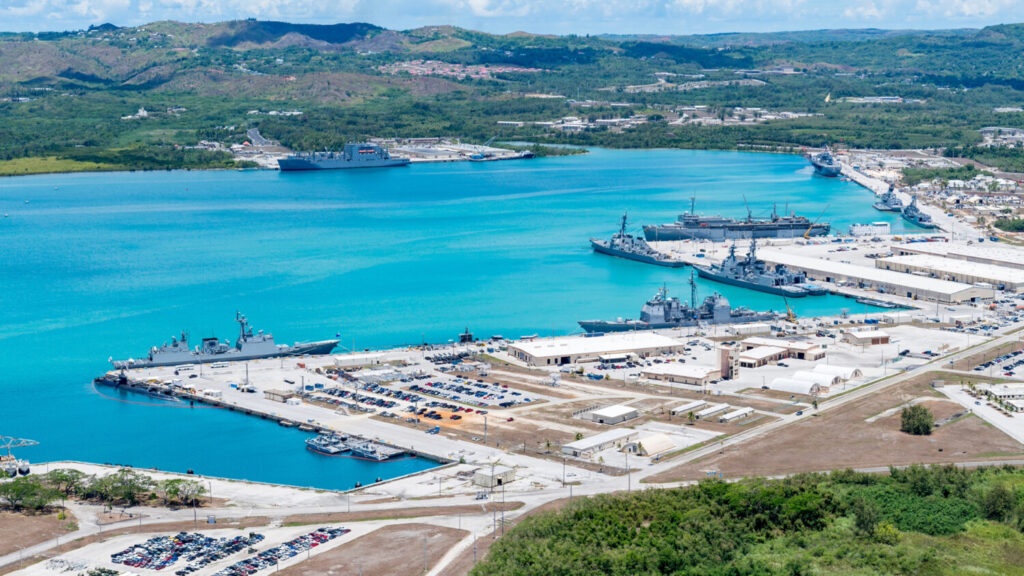The Enhanced Integrated Air and Missile Defense System Amidst Guam’s Strategic Importance
Guam’s geographic position and its role in U.S. force projection make it a critical node for regional security—and a potential target for adversaries such as China and North Korea, both of which have developed ballistic missiles capable of reaching the island.
To keep Guam secured from ballistic missile threats, Washington has finalized plans for an Enhanced Integrated Air and Missile Defense (EIAMD) system to protect the island, allowing for Guam to be converted into a forward operating base whereby the Pentagon can use EIAMD to combat rising threats in the Indo-Pacific while continuing to bolster regional assets.
What is the Enhanced Integrated Air and Missile Defense (EIAMD) System?
The concept of the Enhanced Integrated Air and Missile Defense is for the system to serve as a multi-layered air defense system. Talks of fortifying Guam have been ongoing since August 2022, as The War Zone reported that the MDA’s top leadership was planning new upgrades to protect forward assets.
Guam will be covered by a 360-layered EIAMD, with sixteen locations on the island used for various batteries and interceptors. Both the US Army and Missile Defense Agency (MDA) were awarded the contract to develop and deploy the $8 billion EIAMD to Guam. The Aegis, Standard Missile 3, and 6 missile interceptors (SM-3 and SM-6) will be incorporated into the EIAMD.
Along with various missile interceptors, the Pentagon is considering deploying six radar systems to help track and plot ballistic missile interceptions. According to the Arms Control Association, EIAMD’s implementation will require 400 construction contractors and an additional 2300 permanent and civilian personnel to operate the system.
Integrating Layered Air Defense Systems in Guam
Supplementing Aegis within EIAMD, the US Army and MDA plan on including the Terminal High Altitude Area Defense (THAAD), the Typhon Mid-Range Capability System (MRC), and the Enduring Shield Indirect Fire Protection System. Deploying the various systems will help support the lower layers of Guam’s air defenses.
In May 2023, Asia Times noted that Guam would also receive a disaggregated Aegis Ashore system, which could be installed at Anderson Air Force Base. Furthermore, Guam has strategic topography, from which interceptors could be fired. Yet despite the numerous systems that can supplement Guam’s defense, integration will pose several challenges. For example, integrating key sensor fusion across the different domains of each missile defense system will be needed to keep EIAMD in sync.
Guam’s Assets, Why is it a Prime Target for Adversaries?
Guam’s strategic positioning allows for rapid reinforcements if any conflict were to break out in the Indo-Pacific, as the island is only a few thousand kilometers away from key allies and American military locations in Japan, South Korea, the Philippines, and Australia.
The aforementioned Anderson Air Force Base is crucial for maintaining US strike packages and capabilities. B1 Lancers and B2 Spirit Bombers are stationed there for any critical mission, such as American military operations in the Middle East during the spring and summer of 2025. Furthermore, Anderson’s runways are modified to support all aircraft in the US military’s inventory.
Guam is the central hub for supplementing US fleets such as Fifth and Seventh in their areas of operations in the Indian and Pacific Oceans, respectively. The Defense Logistics Agency’s regional headquarters is also located in Guam to oversee logistical operations in the Asian Pacific. The island is also home to Naval Base Guam, along with a Marine Corps base named Camp Blaz. Currently, 22,000 military personnel, contractors, and civilian dependents are located on the island, with plans to increase numbers to 33,000 by fiscal year 2027.
Why is EIAMD Needed against China and North Korea
American wargame planners calculated that in potential conflict with China, Beijing’s growing ballistic missile capabilities will heavily target Guam. The People’s Liberation Army Rocket Force (PLARF) will utilize the long-range Dongfeng (DF) ballistic missiles to target military bases, such as those located in Guam. The PLARF would likely deploy the Ying-Ji (YJ) 21 hypersonic missile and DF-27 against assets in Guam.
For North Korea, its strategic rocket force (KPASF) could deploy the Hwasong-15, 17, and 20 ballistic missiles against U.S. forces in Guam. The Hwasong-15, 17, and 20 have an estimated range of 13,000 to 15,000 kilometers. Nevertheless, U.S. military planners will have time to counter KPASF missiles as the Hwasong missiles are not perfected to re-enter the atmosphere.
Guam’s Enhanced Integrated Air and Missile Defense is a much-needed layered air defense system that can help protect Guam’s critical assets. With ballistic missile capabilities of China and North Korea becoming more proficient, the United States needs to adapt to growing challenges in the Indo-Pacific region.



